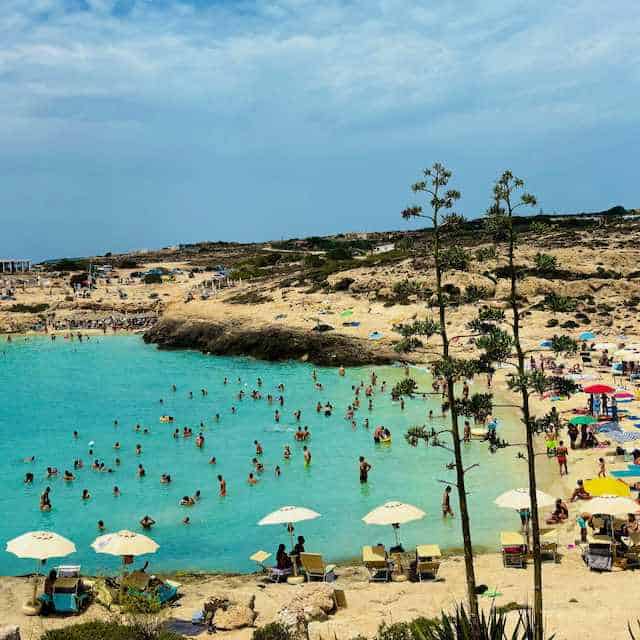
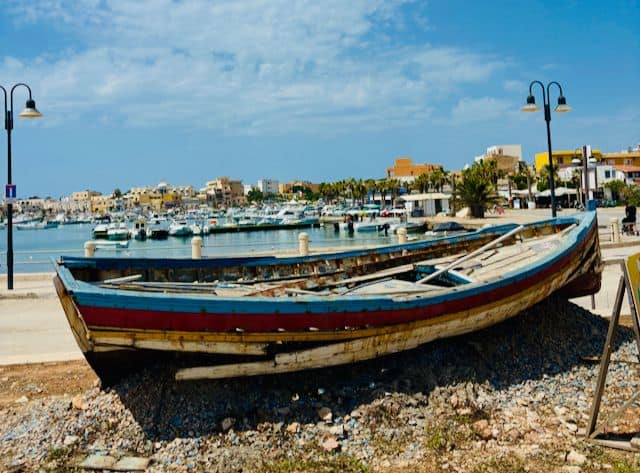
I don’t think I’m exaggerating when I say Italy is one of the world’s most visited countries. Everyone has heard of Rome, Milan, Venice, Florence, Sicily… But not so many know Lampedusa. And looking at a map, you’d be forgiven for wondering what this tiny speck off the coast of Africa has to do with Italy.
Lampedusa is the largest of Italy’s Isole Pelagie – the Pelagie Islands, and the Italians’ secret holiday paradise.
And a well-kept secret it is. Wandering around the main street on the island, I hear only Italian spoken. And most people in shops, cafes, the museum and the national archives, do not speak English or German or French or any other language I’m familiar with.
I haven’t spoken Italian in decades, and even then, I only ever got as far as the present tense. OK, no way around it; have to muster up the necessary self-confidence and jump in. And, I have to say, after just a few days, my Italian improves vastly. As with so many things in life, it’s all about taking that first, slightly awkward step.

Cala Guitgia, the harbour beach
The quiet island
Even now in August, prime holiday season in Europe, Lampedusa is very quiet during the day. The museum, most shops and even some restaurants only open in the evening. But come nighttime, the island’s main street, Via Roma, bustles with life and music.
The rest of the year is quiet, people tell me. Very quiet. Sounds ideal if you want to get things done.
Holiday paradise v. beacon of hope
It’s a place of contradictions this. Seemingly a remote outpost in the vast Mediterranean, it is also at the very centre of one of the most urgent humanitarian issues of our time. Lampedusa is the gateway to Europe for thousands of people fleeing poverty, persecution, conflict, and the horrors of war. Many come from Mali and Burkina Faso, two of the world’s most violent and dangerous countries. They come in search of safety and a better life, much like European migrants once did in the Americas.
Lampedusa has come to represent the ongoing migration crisis that has gripped Europe since the early days of this millennium. In the last decade, more than 22,000 people have died on this North African route alone.
The landscape is stunning! Cool, crystal-clear waters: blue, green and every shade in between. Rugged, steep cliffs and white sand beaches. The most famous is Spiaggia dei Conigli – Rabbit Beach, consistently rated amongst the world’s best. In 2013, TripAdvisor rated it the very best beach in the world.

Rabbit Island, just off Rabbit Beach.
That same year, on 3 October, the island made international news after a boat carrying more than 500 migrants caught fire and capsized just metres from its coast. Most had fled from Eritrea through Libya. At least 360 drowned. One particularly haunting image is of a mother and her son in a coffin, the boy just born, with the umbilical cord still attached.
Just 8 days later, another boat sunk between the Libyan coast and Lampedusa. Of the 268 who drowned, 60 were children – the children’s shipwreck.
Population: 6,000
Migration is not just a current phenomenon for Lampedusa. The strategic location has made it a natural stopover for centuries: from ancient seafarers like the Greeks, the Phoenicians, and the Romans – to today’s migrants attempting the perilous journey across the Mediterranean.
In modern times, this little island has seen thousands of migrants land on their shores, especially during the Arab Spring in 2011 and again with the Syrian conflict in 2015. And it doesn’t appear to end any time soon. At one point in 2023, almost 10,000 arrived within one week, nearly double the number of residents on the 20 km² island. (That’s about the same size as Indira Gandhi Airport in New Delhi in India – and just a bit bigger than LAX.)
On top of that, there is a lack of supplies. Like most remote islands, Lampedusa doesn’t have the resources to be self-sufficient, and imports from the mainland cost money – and time. Even more, when the boats normally used for shipping necessities to and from Lampedusa, are needed to transport migrants from the island to the mainland.
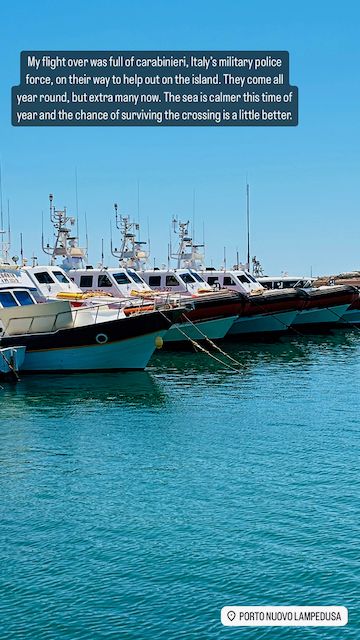
On the flight over from Palermo, I share the small propeller plane with about 20 carabinieri, travelling from Sicily to help out colleagues on Lampedusa. They do this year-round, my seat mate tells me. But more now. At this time of year, the seas are calmer, and more people risk the hazardous crossing. The local police require more help.
I stop by the evocative Museo Archeologico Regionale delle Pelagie. The ground floor covers the ancient history of the islands. The first floor is dedicated to migration.
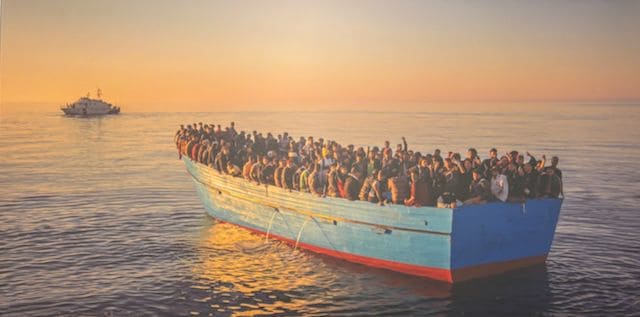
Videos and photos tell heartbreaking stories of people looking for missing family members…
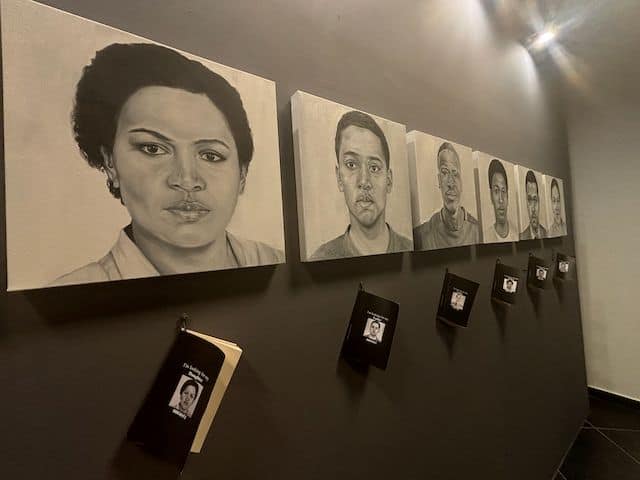
…and rescue crews hauling people up from the ocean

It’s hard enough to watch, let alone doing the job.
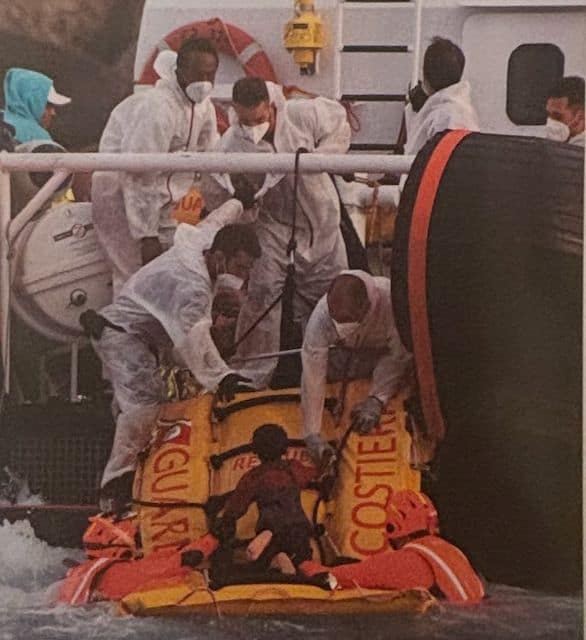
Everyday heroes
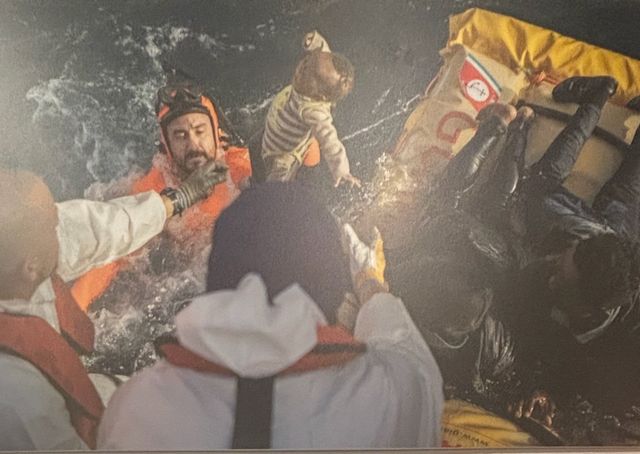
Solidarity
I chat with shop keepers, restaurateurs, random people relaxing on benches. Surely, the migrant crisis must put a strain on the island’s resources? On the people?
There are some practical challenges, they say. The reception centre on the island is frequently overwhelmed; it doesn’t have capacity for 1,000 people arriving all at once. Some say it’s exhausting. Others say it’s not so bad. The migrants are sent to other places – to Sicily, to the mainland. A fisherman tells me about finding people in boats, often nothing more than tiny dinghies. About finding people in the water, sometimes caught in the fishing nets.
I hear no complaints. People welcome refugees into their homes. Restaurants distribute free food. I frequently hear the word solidarity. Did I happen to meet particularly resilient islanders? Perhaps. But I’ll risk a conclusion anyway: Lampedusans are compassionate people. It’s not surprising they were nominated for a Nobel Peace Prize in 2016.
Lampedusa as a tourist destination
The island attracts mostly Italian travellers, but everyone is welcome. Based on my experience in August 2024, it’s an easy place to be. It can be challenging if you are uncomfortable communicating in anything other than English. But most locals are helpful, and will find someone who knows at least a little – kids, their wife, a neighbour… to help out.
There are hotels and rooms to rent here. And for such a small island, there are quite a few cafes/pubs and restaurants offering lots of fish and seafood, and also pizza, pasta, and more. There are gelaterias, of course (my new favourite is almond granita), and several little speciality shops along Via Roma.
Most shops are closed during daytime, when everyone seems to be at the beach. But at night, Via Roma comes alive. Shops open, live music emanate from the two stages along the street and I hear pleasant chatter from outdoor restaurants. People amble about, it’s a relaxed atmosphere. The cinema shows free films outdoors; this is the annual Vento del Nord film festival week.
Getting there and getting around
- The easiest way to get to Lampedusa is by air from Palermo and Catania on Sicily, with a propeller plane from DAT (Danish Air Transport). The flight takes about 50 minutes and operates year round.
- Additionally, in spring and summer, various budget airlines (Volotea, EasyJet, WizzAir, Vueling, etc) fly from Verona, Florence, Perugia, and more.
- A bit more cumbersome, but probably interesting if you have time, is taking the ferry from Porto Empedocle on Sicily (ca. 4 hours).
Transport around the island:
- by bus – there are two routes, a blue and a red, covering the east and west of the island, respectively. As of August 2024, the ticket costs 1.2 EUR
- by foot – I walked everywhere, and clocked just under 46,000 steps one day (new PB!)
- by bike
- by rental car – the old Citroën Mehari just radiates summer fun

What else?
Many of the island’s beaches have on-site cafes/snack bars and sun beds/parasols for hire. Some, like the beautiful Spiaggia dei Conigli, has a small cafe by the road, but no facilities on the beach, a 15-minute walk downhill from the road. It feels like stepping back in time, when a beach was just a beach. I like it!
The story of Lampedusa continues. As long as there are conflicts and inequality, the island seems destined to remain an entryway to Europe for those fleeing their homes to find safety and a better life.
I think this mosaic in front of the island’s church, Chiesa di San Gerlando, has got it right:
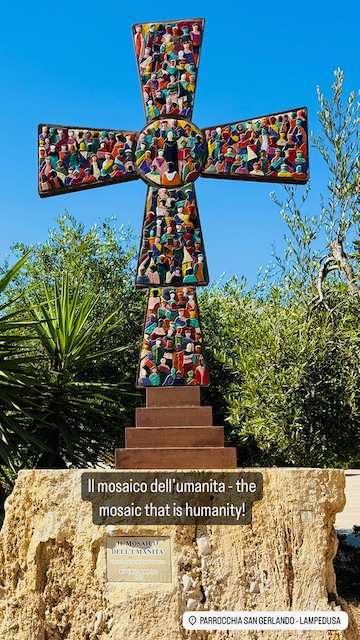
The mosaic of humanity
Please visit:
Our Sponsor
